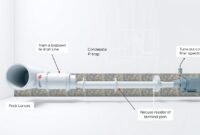Cool air is circulated through supply and return ducts by a central air conditioner. Transport cooled air from the air conditioner to the dwelling via supply ducts and registers (grill-covered holes in the walls, floors, or ceilings).
The cold air flows throughout the home, warming up and returning to the central air conditioner via return ducts and registers. This article will cover several essential matters on central AC, including symptoms of low freon in central air conditioners. Keep on reading!

Do Central Air Units Need Freon?
Yes, most modern air conditioners require Freon to function correctly. However, following the first installation, they only need a new Freon if there is a leak. If you discover your coolant levels are low and you’ve owned your system for years, there’s a significant probability of a leak.
Central AC systems spread air throughout a property using ducting and grills. Freon for the central air unit is heated and cooled by a single central unit inside. This central unit, often located in the basement or loft, employs a fan system to circulate air through a ducting network and into your rooms.
Because ductwork is required, central air conditioning systems may be pretty significant. They are most extensively utilized in the United States and Canada, where most residences and commercial buildings feature an air conditioning system. They are usually used with a furnace or alone to provide hot and cold air.
Because central air conditioning systems have only one internal unit, they chill and heat all property regions to the same temperature. A thermostat is typically used to control this. Retrofitting an existing home with a central air conditioning system is possible. However, this is difficult and costly, so it does not occur frequently.
Symptoms of Low Freon in Central Air Conditioner
Freon is being phased out in favor of more environmentally friendly refrigerants. However, it may still be freon, depending on when you bought your air conditioner. Existing freon systems will need to be recharged with recycled freon beginning in January 2020.
When it comes to recharging the refrigerant, never add extra freon. More should only be added if there is a leak in the system.
Here are 7 symptoms of low freon in central air conditioners:
- It takes a long time for your property to cool down. When your air conditioning unit works harder due to low freon, it becomes harder to cool your home efficiently. This results in high interior temperatures and increases energy bills as the system strains to maintain a comfortable climate.
- The vents are not sending out cold air. Warm or lukewarm air streaming through the vents might signal problems, such as the central air refrigerant leak.
- You will never reach the temperature that you desire. Your air conditioner needs to be repaired if the thermostat is set to 23 degrees Celsius but the thermometer never reaches that temperature.
- Your power bill is significantly greater than usual. A noticeable increase in your electric bill can be a symptom of low freon in your central air conditioner. Utility bills may rise significantly as the system struggles to cool your home. Regularly comparing your bills can help you identify this issue early.
- Ice on refrigerant lines. Ice building up on the copper lines of your air conditioning system is a clear sign of low freon. This occurs when the air conditioner, low on refrigerant, causes ice to form on the copper tubing and evaporator coil, indicating a need for maintenance.
- Water is spilling from the heater. Water might pool near the furnace when the ice that has built up on the refrigerant pipes melts. This water can then go down the drain or into the furnace. There should never be water on the floor near your furnace.
- A hissing or bubbling sound. If you hear a hissing or bubbling sound from your air conditioning unit, it’s likely due to a refrigerant leak, a common symptom of low freon. This sound indicates that the system leaks refrigerant and requires professional attention to fix the problem.
Read also: How to Stop Condensation on Air Vents?
Another symptom of low freon in central air conditioners can be a dirty air filter. When air filters are clogged, the system works harder to circulate air, exacerbating issues caused by low refrigerant levels. Regularly checking and replacing air filters can help maintain system efficiency and reduce the strain on your air conditioning unit.
Bottom Line
The specifications for various appliances may vary over time. As previously stated, older central air conditioning equipment utilizes freon, while newer models use superior refrigerants. Symptoms of low freon in central air conditioners may also vary.
With the information above, you may decide whether to recharge your old unit or purchase a new one! We hope you found the preceding helpful information.


